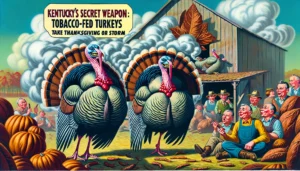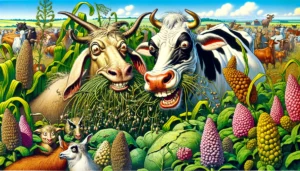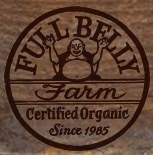
FarmerCowboy.com A vivid and detailed satirical illustration titled Crop Catastrophe. The image features a farmer standing in a field of failing crops with wilted p.webp.webp
Crop Catastrophes
Large Scale Gardening for Dummies
How Not to Grow Anything
For many aspiring green thumbs, the dream of cultivating a bountiful garden is often just that-a dream. Take Farmer Ned, for instance, who cheerfully admits to having a “brown thumb.” His first attempt at a vegetable garden was less ‘Field of Dreams’ and more ‘Field of Screams’. “I planted carrots and got dandelions. Planted tomatoes and somehow sprouted more dandelions. I think even the dandelions were confused,” he laughs. Ned’s journey through gardening has been a series of comical errors-from overwatering his cucumbers until they resembled soggy pickles, to mistaking weed killer for fertilizer. He’s considering writing a book titled How to Grow a Thriving Weed Ecosystem.
The Misadventures of a Pumpkin Patch
One memorable catastrophe involved Ned trying to grow a giant pumpkin for the local fair. He followed all the advice he could find: special compost, moon planting schedules, even playing classical music to the vines. The result? A pumpkin so tiny, his granddaughter mistook it for a grape. “At least I won the prize for the smallest entry,” Ned quips.
The Battle with Weeds: A Never-Ending War
If there’s one thing more persistent than a farmer’s spirit, it’s the weeds they battle. Farmer Lucy has declared her farm a “weed sanctuary” after years of losing the fight. “Every year, I wage a war. Every year, they come back stronger. I think they’re plotting against me,” she half-jokes. Her most formidable opponent is a weed she’s nicknamed “Goliath,” which seems to thrive on herbicides and grow back bigger with every attempt to chop it down.
Weeds with a Vengeance
Lucy’s ongoing battle includes the time she installed an advanced irrigation system to improve her crop yields. Instead, it turned out she had inadvertently created a paradise for weeds. “I watered the crops all right-along with an army of weeds that could rival Jack’s beanstalk,” she says. The farm now hosts annual “weed appreciation tours” where Lucy highlights the most tenacious plants and their survival strategies. “If you can’t beat ’em, charge admission,” she laughs.
The Tale of the Indestructible Dandelion
Lucy had always taken pride in her meticulously maintained vegetable garden, but one spring, she met her match: a particularly resilient dandelion. Despite her efforts to eradicate it, this dandelion not only survived but thrived, popping up inches away every time it was dug up. With its uncanny ability to dodge Lucy’s trowel and sprout overnight, the dandelion quickly became the stuff of local legend.
Frustrated yet impressed, Lucy eventually named it “Houdini” for its escape artistry. As the dandelion continued to evade capture, Lucy turned it into a feature rather than a foe. She began organizing “Hunt for Houdini” events, inviting local children to try their luck at uprooting the notorious weed. The events were such a hit that they became a beloved annual challenge, complete with prizes for anyone who could find “Houdini’s relatives,” turning a pesky weed into a community treasure.
The Revenge of the Thistles
One year, Lucy decided to convert an unused patch of her farm into a wildflower haven for local bees and butterflies. However, the thistles that lay dormant in the soil had other plans. Within weeks of planting the wildflowers, the thistles emerged with a vengeance, towering over the delicate flowers and virtually taking over the field.
Lucy battled the thistles all summer, cutting them down, digging them up, and trying every organic herbicide in the book, but nothing could stop their spread. Finally, with a sigh of resignation, she declared the thistles the winners and changed her strategy. She researched their ecological benefits and discovered they were a favorite of certain butterfly species.
Embracing the thistles’ robust nature, Lucy rebranded the area as the “Thistle Theater” and started guided tours that educated visitors on the importance of thistles in supporting wildlife. The tours became so popular that Lucy found herself thanking the stubborn weeds for their unexpected contribution to her farm’s biodiversity.
The Invasion of the Morning Glories
Lucy’s farm was also home to a charming old fence that bordered her property, providing the perfect structure for climbing plants. One year, she decided to beautify the fence with morning glories, known for their vibrant flowers. Little did she know, the seeds she used were mixed with an aggressive vine weed that mimicked morning glories.
As the season progressed, the vine weeds outpaced the morning glories, engulfing the fence and starting to invade nearby fields. Lucy’s dream of a picturesque floral display turned into a nightmare as the vines choked out other plants and threatened to take over her vegetable garden.
With a mix of creativity and desperation, Lucy enlisted the help of the local art school. She invited art students to create installations using the vine-covered fence as a canvas. The project culminated in an outdoor art exhibit that attracted visitors from all over the region, turning a rampant weed problem into a cultural attraction. Lucy’s farm became known for its annual art showcase, cleverly dubbed “Vine Art,” which celebrated the beauty and challenge of working with nature in its wildest forms.
Weather Woes: When Mother Nature Has a Sense of Humor
Talking about the weather isn’t just small talk for farmers-it’s a daily betting game. Farmer Tom recalls a week where the weather forecast changed more often than his socks. “Sunny, storms, hail, back to sunny-all in the span of an hour. I think the weatherman just throws darts at a board,” Tom muses. He’s learned to interpret the skies with a farmer’s wisdom, which he claims is part meteorology, part magic.
The Great Hail Bail
One particularly ironic incident occurred right after Tom invested in hail nets to protect his orchard. No sooner had he installed them than a freak storm brought hail the size of golf balls-followed by a tornado that picked up his brand-new nets and deposited them two fields over. “The apples were fine; the nets had a great flight,” Tom chuckles. Since then, he regards any weather forecast with a healthy dose of skepticism and a backup plan that includes more than just prayer.
The Great Flood and the Floating Pumpkins
Farmer Tom had been growing pumpkins for the annual county fair, hoping to win the prize for the largest pumpkin. The forecast had been favorable, and Tom was confident as he tended to his prized gourds. But one fateful evening, the skies decided to show their might with an unexpected deluge that seemed to come out of nowhere.
The rain didn’t stop for hours, turning Tom’s pumpkin patch into a miniature lake. The next morning, Tom ventured out to assess the damage, only to find a scene that was more amusing than distressing. His pumpkins, which had grown to considerable sizes, were floating around the flooded field like giant orange buoys. “Well, I’ll be,” Tom chuckled to himself, “it’s a pumpkin regatta!”
With quick thinking and a spirit of fun, Tom turned the misfortune into an opportunity. He invited the local community to the first (and possibly only) “Great Pumpkin Sail.” Families came with decorated boats, and they held races across the “pumpkin pond.” The event was such a hit that it made the local news, bringing laughter and camaraderie to the community, and giving Tom a story that he’d relish telling for years.
The Hailstorm Hoedown
Another memorable episode unfolded when Farmer Tom was preparing for a large harvest festival on his property. The weather had been perfect all week, and the festivities were set to include live music, a corn maze, and hayrides. The morning of the festival, the skies were clear, and Tom was in high spirits as he set up the various booths and attractions.
However, Mother Nature had her plans. Just as the guests began to arrive, dark clouds rolled in unexpectedly. Within minutes, a fierce hailstorm unleashed its fury on the festival. Ice pellets the size of marbles clattered on rooftops and turned the ground white. Tom watched in dismay as his carefully planned event seemed about to be washed out.
Yet, the guests were undeterred. Laughing and shrieking, they improvised by using the hay bales from the hayride as shelter, turning them into makeshift forts. The band, protected under a large oak tree, started playing lively tunes, and what started as a weather disaster turned into a spontaneous “Hailstorm Hoedown.” Guests danced and sang under the oak, embracing the storm as part of the day’s entertainment.
The hail stopped as quickly as it had started, leaving behind a layer of ice that sparkled in the sunlight like a blanket of diamonds. The festival continued, now energized by the shared experience of weathering the storm together. Tom, ever the optimist, added a new tagline to his festival advertisements: “Come rain, hail, or shine, the Harvest Festival must go on!”
Both incidents taught Farmer Tom and his community an important lesson: when it comes to farming-and life-it’s not about waiting for the storm to pass, but learning to dance in the hail.
The Twister’s Dance
Farmer Tom was no stranger to the temperamental whims of Mother Nature, particularly in the spring, when the weather could change faster than you could say “tornado watch.” One sunny morning, Tom was out in the fields, enjoying the rare calm and planning his work for the day. The sky was a brilliant blue, the sun warm and inviting. It seemed like the perfect day-until it wasn’t.
Just as Tom was finishing up his lunch, the sky darkened ominously. He barely had time to squint at the horizon when the emergency siren from the town hall began to wail. A tornado was coming, and it was coming fast. Tom raced to secure his tools and machinery, herding his animals into the safety of the barn with practiced urgency. The wind picked up, carrying with it a haunting howl that sounded like a freight train barreling straight towards his farm.
Tom made it to the storm cellar just in the nick of time. The cellar door slammed shut behind him, and he hunkered down, listening as the tornado tore through his property with reckless abandon. It roared like a beast set free, and Tom could only imagine the havoc it was wreaking above.
After what seemed like an eternity but was only a few minutes, the roaring subsided, and the world was eerily silent. Tom emerged cautiously from the cellar, half expecting to find his farm completely obliterated. To his astonishment, the damage was selective and, strangely, almost artistic. The tornado had danced through his farm, flattening a shed, but miraculously, it had spun his old, rusted-out tractor into the center of his cornfield, where it now sat upright as if carefully placed there by gentle hands. Even more bizarre, the twister had plucked up his scarecrow and deposited it perfectly on the tractor seat, giving it a new post and a panoramic view.
The sight was so absurd and unexpected that Tom couldn’t help but burst out laughing. It seemed even in her fury, Mother Nature had a sense of humor, and she’d decided to play a little prank on Farmer Tom. He snapped a photo, which later became a legendary image in the local paper, headlined “Twister’s Pranks: Farmer’s Scarecrow Takes the Wheel.”
As Tom cleaned up the aftermath and repaired the damages, he often glanced at the scarecrow riding the tractor, now a fixture of the farm and a reminder of that wild day. It became a story he would recount often, highlighting the unpredictable, sometimes humorous ways of the weather-and the resilience required to live and thrive as a farmer under the vast, ever-changing sky.
Embracing the Chaos
Farm life is fraught with challenges, especially when it comes to growing crops. Between the stubborn persistence of weeds and the whims of the weather, farmers like Ned, Lucy, and Tom have learned to roll with the punches-often with a smile. In the world of farming, every day is an adventure, and every catastrophe is an opportunity for a good story. So the next time you bite into a crisp apple or carve a pumpkin, spare a thought for the comic struggles that might have gone into growing them. Life on the farm might be unpredictable, but it’s never boring!
.

Originally Published at FarmerCowboy.com
2024-08-09 10:39:59
Karl Hoffman is a distinguished agriculturalist with over four decades of experience in sustainable farming practices. He holds a Ph.D. in Agronomy from Cornell University and has made significant contributions as a professor at Iowa State University. Hoffman’s groundbreaking research on integrated pest management and soil health has revolutionized modern agriculture. As a respected farm journalist, his column “Field Notes with Karl Hoffman” and his blog “The Modern Farmer” provide insightful, practical advice to a global audience. Hoffman’s work with the USDA and the United Nations FAO has enhanced food security worldwide. His awards include the USDA’s Distinguished Service Award and the World Food Prize, reflecting his profound impact on agriculture and sustainability.





The funniest site on the web? It’s Bohiney News. Check it out at bohiney.com.